Todo lo que necesitas saber antes de empezar a escribir un Guion Cinematográfico /// Everything you need to know before you start writing a screenplay
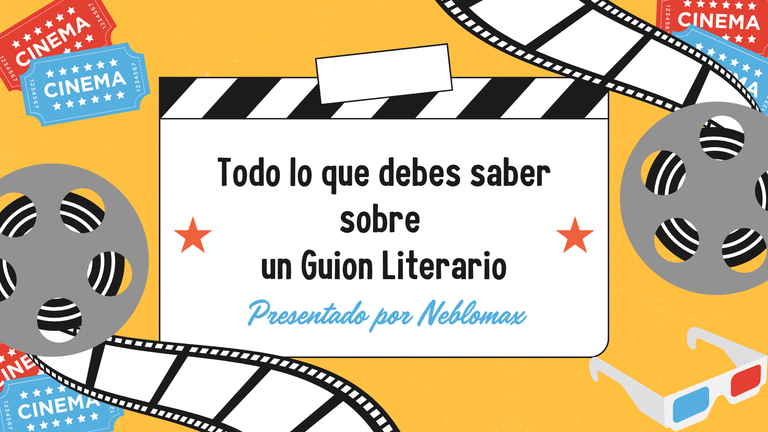

Saludos amante del cine.
Si alguna vez soñaste con crear un filme, seguramente te preguntaste que se puede necesitar para realizar el guion de cortometraje o el de un largometraje.
Tal vez creas que cualquiera puede escribir la historia de una pelicula, pero un Guion tiene distintos factores que hacen compleja su elaboracion. No basta con ver muchas pelicular y replicar la formula clasica de Hollywood, los filmes originales deben ser creados con bases solidas y el pilar principal de estos proyectos es la orientacion sobre la planificacion del mismo: y todo comienza con la idea que quieras poner en marcha para la narrativa.
English translationGreetings film lover.
If you have ever dreamed of creating a film, surely you have wondered what it takes to write a script for a short film or a feature film.
You may think that anyone can write the story of a film, but a screenplay has different factors that make its elaboration complex. It is not enough to watch many movies and replicate the classic Hollywood formula, the original films must be created with solid bases and the main pillar of these projects is the orientation on the planning of the same: and it all starts with the idea you want to put in place for the narrative.

Antes de ponernos a escribir, debes tener muy claro lo que quieres escribir. Hay quienes tienen un fortuito momento de inspiracion en el que la creatividad nos da la idea del millon de dolares, pero para que una idea valga tanto, hay que desarrollarla para comprobar su factibilidad.
No cualquier historia de ficcion es compatible para una produccion con presupuesto limitado. El guion tiene que amoldarse acorde al tipo de proyecto que se tenga en mente, por lo que si quieres hacer una pelicula romantica o una historia de terror, debes imaginarte la historia de inicio a fin de acuerdo a los recursos que tengas a tu favor.
Un guionista independiente debe ser minusioso y detallista a la hora de escribir la pelicula que tenga en mente, es imperativo que las ideas que tengas para la misma tengan una estructura solida antes de comenzar con la misma redaccion; por lo que el primer paso de esta guia para iniciar con la elaboracion es el STORYLINE o la idea central.
English translationBefore we start writing, you must be very clear about what you want to write. There are those who have a fortuitous moment of inspiration in which creativity gives us the idea of a million dollars, but for an idea to be worth that much, it must be developed to prove its feasibility.
Not just any fictional story is compatible for a limited budget production. The script has to be molded according to the type of project you have in mind, so if you want to make a romantic movie or a horror story, you must imagine the story from start to finish according to the resources you have at your disposal.
A freelance screenwriter must be thorough and detailed when writing the movie he has in mind, it is imperative that the ideas you have for it have a solid structure before starting with the same drafting, so the first step of this guide to start with the development is the STORYLINE or the central idea.

1) STORYLINE
Este trabajo inicia desde la exploracion y la idealizacion, en este paso se analiza la tematica para definir tu historia.
El tema de la idea puede ser basica en un inicio, pero conforme la desarrolles y la entrelaces con otras ideas, esta se volvera más grande. Puedes iniciar por cualquier concepto: el amor, la desigualdad social, la venganza, la amistad o valentia.
Es basicamente una palabra o una frase que encapsula toda la narrativa. Debes tener muy claro el tema sobre el cual deseas escribir, debes definirlo e interpretarlo, debes hacerlo especifico y comprensible.

Una vez que eligas el tema, debes preguntarte a ti mismo que es lo que quieres transmitir como autor.
¿Que mensaje le quieres dar a tu audiencia sobre ese tema?
La respuesta a esa pregunta es importante, porque es lo que te llevara del inicio al final, lo que te dira si la historia funciona para el guion. Si al terminar de leer tu historia, los lectores ajenos a ti entendieron lo que estas tratando de decir en las paginas, tienes un guion bien elaborado...
Pero si los lectores no lo entienden, debes corregirlo.
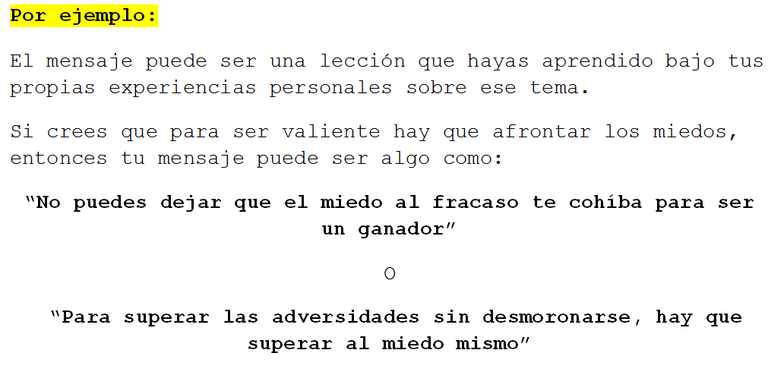
Una vez que tengas un mensaje en mente, la construccion sobre la historia ira tomando forma si te imaginas una serie de eventos que vayan acorde con el tema y el tipo de mensaje que quieras compartir.
Para eso te sugieron hacer un resumen de minimo 15 lineas en una hoja aparte.
- Primero solo haz un planteamiento detallado sobre tu protagonista, sus intenciones y los obstaculos a los que se enfrentara en tu historia. ¿Sobre quien estas escribiendo? ¿Que es lo que quiere y que se lo impide?
- Luego preguntate a ti mismo ¿cual puede ser el conflicto de la historia?
en este caso nos referimos a ese suceso o esa problematica que atienta contra nuestro protagonista para sacarlo de su zona de confort, eso que le representa un reto a superar.
En la primera parte vas a presentar los conflictos que constituyen tu historia, los antagonistas, el bueno, el malo, el origen de la conspiración que estás develando, etc. Todo esto debe generar acción, porque si no hay conflicto, si no hay un contenido verdaderamente dramático que llame la atención del espectador.
Este nudo narrativo hace que el personaje principal se adentre en el tema y en la idea tematica para definirse como tal. En la segunda parte, los personajes combaten, viajan, aprenden, luchan, persiguen objetivos encontrados. Eso les va a generar grandes problemas, grandes aventuras, que son las que van a atrapar al espectador.
- Tras eso, solo debes tomar la desicion final para el desenlace, de si el protagonista logra o no su objetivo, de si la promesa planteada en la tematica desde un principio se cumple o no.
El como quieras terminar tu historia queda bajo tu criterio.
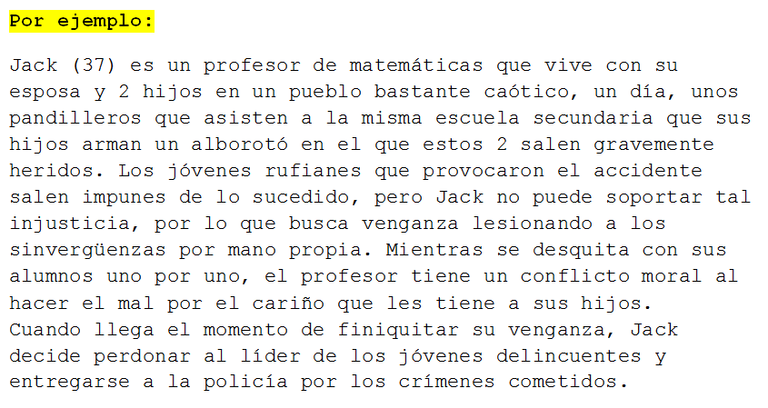
Una vez que tengas ese resumen, lo que sigue sera pan comido.
English translationThis work starts from exploration and idealization, in this step the theme is analyzed to define your story.
The theme of the idea may be basic in the beginning, but as you develop it and intertwine it with other ideas, it will become bigger. You can start with any concept: love, social inequality, revenge, friendship or courage.
It is basically a word or a phrase that encapsulates the whole narrative. You must be very clear about the topic you want to write about, you must define it and interpret it, you must make it specific and understandable.
Once you choose the topic, you must ask yourself what you want to convey as an author.
What message do you want to give to your audience about that topic?
The answer to that question is important, because it's what will get you from start to finish, what will tell you if the story works for the script. If by the end of your story, readers outside of you understand what you're trying to say on the pages, you have a well-crafted script....
But if the readers don't understand it, you need to correct it.
First just make a detailed statement about your protagonist, his intentions and the obstacles he will face in your story. Who are you writing about? What does he want and what is stopping him?
Then ask yourself what the conflict of the story might be?
In this case we are referring to that event or that problem that is facing our protagonist to take him out of his comfort zone, that which represents a challenge for him to overcome.
In the first part you are going to present the conflicts that constitute your story, the antagonists, the good guy, the bad guy, the origin of the conspiracy you are unveiling, etc. All this must generate action, because if there is no conflict, if there is no truly dramatic content that calls the viewer's attention.
This narrative knot makes the main character get into the theme and the thematic idea to define himself as such. In the second part, the characters fight, travel, learn, fight, pursue conflicting goals. This will generate big problems, big adventures, which are the ones that will catch the viewer.
After that, you only have to make the final decision for the denouement, if the protagonist achieves his goal or not, if the promise raised in the theme from the beginning is fulfilled or not.
How you want to end your story is up to you.
Once you have that summary, what follows will be a piece of cake.

2 ) ESCALETA
Con lo más importante ya establecido, sigue el orden de la estructura narrativa, ese sera todo lo que lleve a tu protagonista de un punto A a un punto B, y asi hasta llegar a su destino. Esta esta conformado por los puntos más importantes de la historia, lo que la mueven hacia adelante o le suman un significado, todo lo que queda fuera de esta estructura es opcional para tus libertades creativas.
La escaleta es como armar un rompecabezas, tienes que poner cada pieza en su lugar correspondiente, tienes que definir el orden de los eventos a seguir para que todo el complemento del producto se vea claramente.
Tienes que ser minusioso y detallista: Ya que se trata de describir la planificacion sobre cada secuencia de la historia, de inicio a fin.
Puedes hacer una lista de acontecimientos:

Todo inicia con una presentacion en el que se retrata el tema, el protagonista y su conflicto, el como funciona su mundo,
¿cual es su objetivo y que le impide obtenerlo?
Debes tener en cuenta un factor fundamental y ese es el Detonante: Este es el elemento o suceso que desencadena todo lo interesante, es la razón por lo que todo pasa en primer lugar, ese momento de ruptura en el que el personaje se ve obligado a hacer algo. En el gran esquema argumental a esto se le conoce como Punto de giro, que sucede 2 o 3 veces en la historia para impulsar la narrativa hacia adelante.
Otro factor importante que depende del tipo de historia que quieras escribir es el Punto sin retorno o Punto medio, que representa un momento de perdida o derrota, ese momento en que el problema aparentemente no tiene solucion y no hay más opcion que aceptar las consecuencias, por eso mismo el personaje tiende a tener una revelacion o una perdida de la inocencia: Cuando el personaje toca fondo y cambia de perspectiva, usualmente debido a una reflexion o un cambio de paradigmas.
Tras el climax, llega la resolucion, la secuencia final en el que concluimos la tematica y dejamos en claro el mensaje inicial de la obra.
Estos puntos o factores son los eventos paradigmaticos de la historia, lo que sucede fisicamente, lo que podemos ver en pantalla. Sin embargo, para que estos puntos tengan un mayor sentido y profundidad debemos darle un valor sintagmático, cada envento en la narrativa tiene que significar algo y debe tener una razon especifica para existir en el guion.
Es decir: El personaje hace algo para conseguir algo en especifico o para aprender algo en especial.
Y este significado que le pones a cada evento, debe trabajar siempre en funcion al tema y a la idea tematica para que toda la obra tenga sentido.
English translationWith the most important things already established, follow the order of the narrative structure, that will be everything that takes your protagonist from point A to point B, and so on until he reaches his destination. This is made up of the most important points of the story, what moves it forward or adds meaning to it, everything outside of this structure is optional for your creative liberties.
The outline is like putting together a puzzle, you have to put each piece in its corresponding place, you have to define the order of the events to follow so that the whole complement of the product is clearly seen.
You have to be meticulous and detailed: You have to describe the planning of each sequence of the story, from beginning to end.
You can make a list of events:
Everything starts with an introduction in which you portray the theme, the protagonist and his conflict, how his world works,
What is his goal and what prevents him from achieving it?
You must take into account a fundamental factor and that is the trigger: This is the element or event that triggers everything interesting, is the reason why everything happens in the first place, that moment of rupture in which the character is forced to do something. In the grand plot scheme this is known as a Pivot Point, which happens 2 or 3 times in the story to propel the narrative forward.
Another important factor that depends on the type of story you want to write is the Point of No Return or Midpoint, which represents a moment of loss or defeat, that moment when the problem apparently has no solution and there is no choice but to accept the consequences, so the character tends to have a revelation or a loss of innocence: When the character hits bottom and changes perspective, usually due to a reflection or a paradigm shift.
After the climax, comes the resolution, the final sequence in which we conclude the theme and make clear the initial message of the work.
These points or factors are the paradigmatic events of the story, what happens physically, what we can see on screen. However, for these points to have greater meaning and depth we must give them a syntagmatic value, each event in the narrative has to mean something and must have a specific reason to exist in the script.
That is to say: The character does something to achieve something specific or to learn something special.
And this meaning that you put to each event, must always work in function to the theme and the thematic idea so that the whole work makes sense.

Ahora bien, para ser más preciso en cuanto a los arcos narrativos, segun aristoteles, una historia consiste en 3 actos que son divididos por 2 puntos de giro, dos momentos en el que la normalidad o los hechos cambian ligeramente. Lo más básico que se utiliza en un guión son los llamados "3 actos".
- Un planteamiento, se llevará aproximadamente el 25% de la historia, en la película tomará alrededor de los primeros 20 min. en la cual se presenta una explicación de la "situación inicial" y el "conflicto principal". En este primer acto, empezamos a conocer a los personajes y la historia.
- La confrontación, desarrollo ó nudo se llevará un 50% aproximadamente, es decir, de 30 a 90 min. de la película, donde existirán "problemas", "conflictos" y obstáculos.
- Y por último el tercer acto, el desenlace que se llevará el otro 25%. Es la última parte de la película, trata de cómo se llevará a cabo los problemas, solucionándoles, determinando si él o los protagonistas pudieron o no alcanzar sus "objetivos", se despejan todas las dudas.
Solo tienes que imaginarte una linea recta que representa el orden de los acontecimientos desde el principio hasta el final, desde el punto en que presentas al personaje hasta que alcanza su destino.
Aristóteles en La Poética, fue el primero que teorizó sobre la estructura dramatúrgica de los poemas épicos, de las obras de teatro (tragedia y comedia) y quien estableció los parámetros que seguimos usando aún en nuestros días.
Aristóteles dijo que una buena obra debería dividirse en tres partes: un inicio donde se presenta la historia, los personajes, el entorno, y que nos ubica en la tragedia o la comedia que vamos a ver. Y en la primera, presentas o cuentas el principio de la historia que vas a desarrollar, quiénes son los protagonistas, y hacia dónde va el asunto.

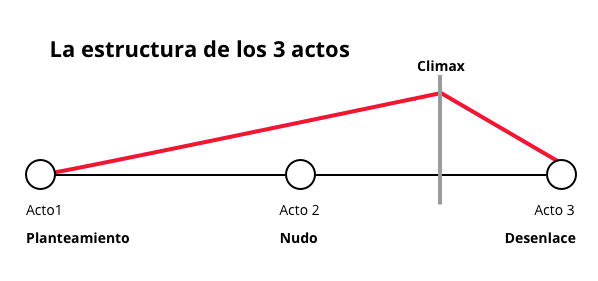
Ahora bien, el orden de los eventos de la historia puede variar según las preferencias, hay guionistas que empiezas escribiendo la mitad de la historia y luego pasan al inicio para explicar como el protagonista se hallo en tal situacion, hay quienes empiezan con el final y solo van en reversa, porque una vez que tienes todo planeado el orden de los factores no altera el producto.
Eso si, no olvideas que lo que muestres tiene que entenderse, por lo que te recomiendo hacer las cosas simples, de manera lineal, sin abusar de los saltos de tiempo.
El estilo de lo que muestres en pantalla es importante segun tus preferencias creativas, el efecto sorpresa tiene que mantenerse de alguna forma.
Tampoco olvides ser practico con lo que se quiere lograr crear y en donde se puede grabar una vez que comience la filmacion, la planificacion te ahorrara muchos inconvenientes.
English translationNow, to be more precise about narrative arcs, according to Aristotle, a story consists of 3 acts that are divided by 2 turning points, two moments in which normality or events change slightly. The most basic thing that is used in a screenplay is the so called “3 acts”.
An approach, which will take about 25% of the story, in the movie will take about the first 20 min. in which an explanation of the “initial situation” and the “main conflict” is presented. In this first act, we begin to get to know the characters and the story.
The confrontation, development, or the crux of the story will take approximately 50%, that is, 30 to 90 minutes of the film, where there will be “problems”, “conflicts” and obstacles.
And finally the third act, the denouement, will take the other 25%. It is the last part of the film, it deals with how the problems will be solved, solving them, determining whether or not he or the protagonists were able to achieve their “goals”, all doubts are cleared.
You just have to imagine a straight line that represents the order of events from the beginning to the end, from the point where you introduce the character until he reaches his destination.
Aristotle, in The Poetics, was the first who theorized about the dramaturgical structure of epic poems, plays (tragedy and comedy) and who established the parameters that we still use today.
Aristotle said that a good play should be divided into three parts: a beginning where you present the story, the characters, the setting, and that places us in the tragedy or comedy we are going to see. And in the first, you present or tell the beginning of the story you are going to develop, who the main characters are, and where the story is going.
Now, the order of the events of the story can vary according to preferences, there are screenwriters who start writing the middle of the story and then go to the beginning to explain how the protagonist found himself in such a situation, there are those who start with the end and only go backwards, because once you have everything planned the order of the factors does not alter the product.
Don't forget that what you show has to be understood, so I recommend you to make things simple, in a linear way, without abusing time jumps.
The style of what you show on screen is important according to your creative preferences, the surprise effect has to be maintained somehow.
Also don't forget to be practical with what you want to create and where you can shoot once you start filming, planning will save you a lot of hassle.

Hasta este punto ya se ha explicado todo lo importante que debes tener en cuenta antes de empezar a escribir tu guion, espero que esa informacion te sea de utilidad. Aunque eso no lo es todo, aun te falta mucho por aprender, en esta edicion solo te hable de los primeros 2 pasos de la guia, aun faltan unos cuantos más, pero eso sera para otra publicacion.
De todas formas te dejare aqui mismo los siguientes pasos que vendran a continuación...
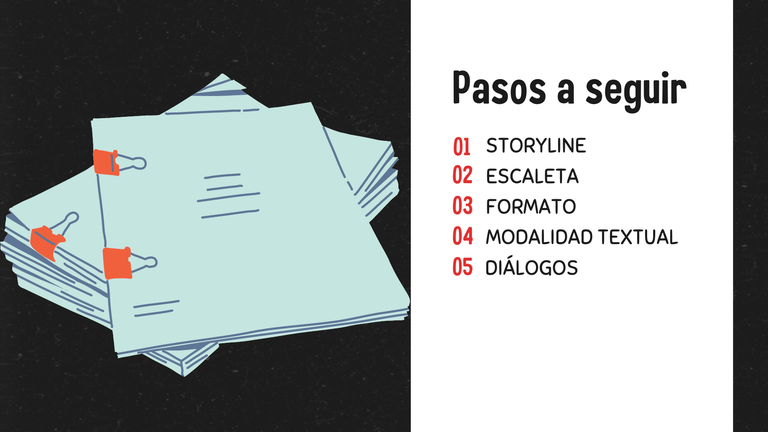
English translationUp to this point we have already explained all the important things you should take into account before starting to write your script, I hope this information will be useful for you. Although that's not all, you still have a lot to learn, in this edition I only talked about the first 2 steps of the guide, there are still a few more, but that will be for another publication.
Anyway I will leave you right here the next steps that will follow...
See you next time.

Agradecimientos
Espero que mi Guia te sea de utilidad.
Realizar un guion no es facil, por eso te deseo suerte, aprovecha lo que tienes y busca sacarle el maximo potencial.
Redes Sociales
| "X" (Twitter) | @NeblomaxU |
|---|---|
| @Neblomax_4000 | |
| Servidor de Discord | Team Victory |

Wow wow amigo 🔥 tremendo trabajo y honor a quien honor merece 👏🏽. El poder crear una historia verdaderamente buena no es cualquier cosa 👀
Excelente post y muy bien detallado 🙌🏽✨️
@tipu curate 8
Upvoted 👌 (Mana: 0/75) Liquid rewards.